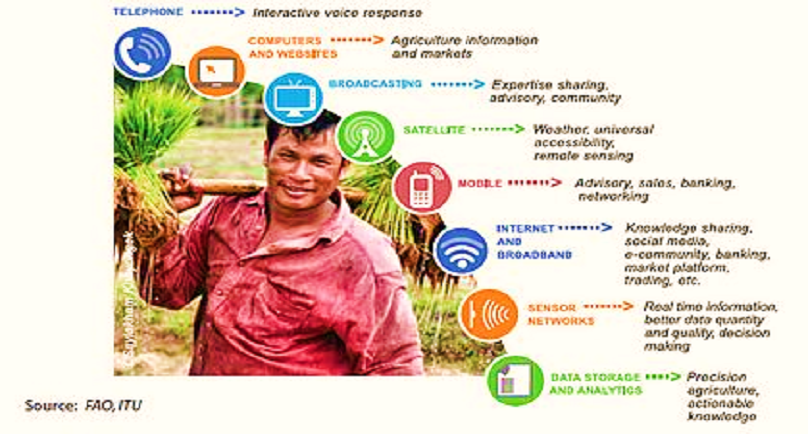Information and Communication Technology in Agriculture (ICT in agriculture), also called E-agriculture, is the developing and applying of innovative ways to use ICT in the rural domain.
ICT in agriculture offers a wide range of solutions to challenges faced. It is seen as an emerging field focusing on the enhancement of agricultural and rural development through improved information and communication processes.
In this context, ICT is used as an umbrella term encompassing all information and communication technologies including devices, networks, mobiles, services and applications; these range from innovative Internet-era technologies and sensors to other pre-existing aids such as fixed telephones, televisions, radios and satellites.
Specifically, e-agriculture involves the conceptualisation, design, development, evaluation and application of innovative ways to use ICTs in the rural domain, with a primary focus on agriculture. Provisions of standards, norms, methodologies, and tools as well as development of individual and institutional capacities, and policy support are all key components of E-agriculture.
E-Agriculture is one of the action lines identified in the declaration and plan of action of the World Summit on the Information Society (WSIS). The “Tunis Agenda for the Information Society,” published on November 18, 2005 and emphasises the leading facilitating roles that UN agencies need to play in the implementation of the Geneva Plan of Action.
The Food and Agriculture Organisation of the United Nations (FAO) has been assigned the responsibility of organising activities related to the action line under C7. ICT Applications on E-Agriculture.
Many ICT interventions have been developed and tested around the world, with varied degrees of success, to help agriculturists improve their livelihoods through increased agricultural productivity and incomes, and reduction in risks.
The FAO-ITU E-agriculture Strategy Guide was developed by the Food and Agriculture Organization (FAO) and the International Telecommunication Union (ITU) with support from partners including the Technical Centre for Agricultural and Rural Cooperation (CTA) as a framework for countries in developing their national e-agriculture strategy or master-plan.
Some of the countries who are using the FAO-ITU E-agriculture Strategy Guide to develop their national strategy are Bhutan, Sri Lanka, Papua New Guinea, Philippines, Fiji and Vanuatu. The guide provides a framework to engage a broader stakeholder in the development of national E-agriculture strategy.
ICTs play an increasingly important role in agricultural value chains. Though important, cell phones aren’t the only ICT being used to improve agriculture. ICTs encompass radios, digital cameras, geographic information systems (GIS), cloud computing, tracking mechanisms and many more.
Five ways in which ICT can help tackle key challenges in agricultural value chain development are:
- Pricing and weather information systems
- Applications (apps) to help buyers manage transactions with the thousands of small-scale farmers who supply to them
- Mobile banking and apps that facilitate quick payments
- Initiatives to expand the reach of farm extension services through phone, radio, video and sometimes all three
- SMS or text messaging campaigns for enabling environment advocacy
The increasingly important role of ICTs in agriculture can help change the face of the sector (from outmoded to cutting edge).


